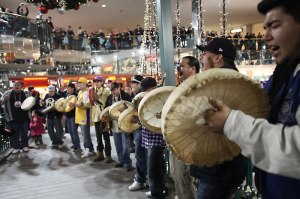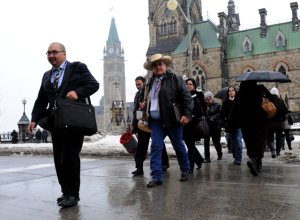Chief Spence Calls for Indian Act Chiefs to “Take Control” of Grassroots Movement
“An uncomfortable analysis, but one we must carry over to other struggles.” -d.
by Zig Zag,
During a Dec 30 press conference on her 20th day of hunger striking, Attawapiskat chief Theresa Spence called on other Indian Act chiefs to take control of the grassroots movement, stating in a written text (read out by one of her aides): “First Nations leadership needs to take charge and control of the situation on behalf of the grassroots movement.”

It would appear to be a poor political move on her part, revealing the historical role of the Indian Act band councils in controlling Indigenous peoples and suppressing any real grassroots resistance. Yet it will undoubtedly hold some significance among the more naive participants in Idle No More, who early on began promoting the chief as a heroic leader of the grassroots.
Chief Spence also seems unaware that many of the rallies, highway, and even train blockades, were promoted and assisted by the band councils from the start. Perhaps the only actions that haven’t seen the chiefs as central players have been the flash mobs.

It is ironic that what began as a grassroots movement against Bill C-45 has morphed into one that backs the central demands of chief Spence: a meeting between the Prime Minister, the Governor-General, and an undefined “First Nations leadership,” which can only mean the Indian Act chiefs. Ironic because it is due, in part, to the work of the Indian Act band councils that there isn’t a stronger grassroots Indigenous resistance in Canada. They are tools of counter-insurgency, commonly used by colonial regimes throughout history.
Spence’s hunger strike has been a central component in the mobilization of INM over the last three weeks. While fasting has spiritual significance among virtually all Indigenous peoples, we also need to remember that she is doing it as an act of civil disobedience to pressure the government to meet her demands. Many Natives appear to be caught up in a spiritual mysticism due to the fact that she is on a hunger strike and ignore the fact that she is also a political actor: a band council chief with a political agenda.

Gandhi, for example, used and abused hunger strikes throughout his political career. He used them to protest British policies, to pressure political opponents to submit to his will, and as punishment against his disciples who violated his many rules of conduct (as a lawyer he liked making laws, it would seem).
Spence’s statement calling for the chiefs to take control comes two days after INM’s “official” organizers issued a statement attempting to impose pacifist codes of conduct on INM participants (“Idle No More calls for only peaceful acts of resurgence” Idle No More website, Dec 28, 2012).
INM has no doubt been a very empowering experience for thousands of Indigenous people across Canada, many of whom can truly said to have been formerly “idle.” This may be its single greatest achievement. But it was exploited early on by the Indian Act chiefs to pressure the government in their own private dispute with Ottawa (for money & power).

It was reformist from the start, despite the rhetoric about “revolution.” And, while much attention has been focused on the fact that INM was started by four women, little has been said about the fact that they’re also middle-class lawyers and university professors (who sound like they’re using Professor Taiaiake Alfred’s Wasase book, a pacifist guide to “resurgence,” as their guide book).
They did a great job analyzing Bill C-45 (being lawyers and academics, it’s right up their alley). But does this mean they are therefore capable of directing and controlling a grassroots resistance movement, comprised of many diverse peoples and groups?
The very idea that any one group of people can dictate the methods, tactics, strategies and objectives is itself contrary to the nature of genuine grassroots movements. They are comprised of diverse individuals and groups, self-organized in an autonomous and decentralized manner. Just like many of our peoples were, prior to colonization and the imposing of the Indian Act.
The middle-class reformists who started this movement, along with the Indian Act chiefs, are now attempting to impose greater control over what they perceive as a potential rebellion they will be unable to contain. This is always the problem with arousing the grassroots people, but then that’s what the Indian Act band councils were created for, even if they sometimes use this threat as leverage in their disputes with the government.
It may indeed be that the greatest achievement of INM is in mobilizing thousands of formerly “idle” Natives into the streets in opposition to government policies. But this achievement will be tempered by the fact that it was exploited from the start by Indian Act chiefs, who will reaffirm themselves in the minds of some as genuine “leaders” of the grassroots. Chief Spence will have played an important role in this co-optation, regardless of the praise she has received.
As a reformist movement, INM has been severely limited, despite the extent of mobilizing achieved. It was entirely focused on legal-political methods, which the rallies and acts of civil disobedience were meant to reinforce. The main “actions” carried out have been rallying large numbers of people and mostly symbolic displays of power (i.e., temporary blockades of highways and trains). It has psychologically disarmed people and diminished their warrior spirit with its emphasis on “peaceful” protests. And, like other reformist movements, it isn’t even about real social change. It’s actually about maintaining the status quo. The imposing of control by the Indian Act chiefs over a grassroots movement is itself an example of the status quo, and genuine grassroots Native people should reject this.
Whatever the latest slogan or trend, or title attached, the real grassroots has always been here and always will be. It has been engaged in over 500 years of resistance to colonization, generation after generation. That is, in part, how we as Indigenous peoples have survived to this day. No Indian Act chiefs or band councilors, no middle-class academics or lawyers, can claim this resistance as theirs. Nor are we obliged to follow their dictates.
Also see: Analysis of Idle No More Mobilization, Resist the Assimilation of First Nations and the Mohawk Nation News Editorial IDLE NO MORE.

